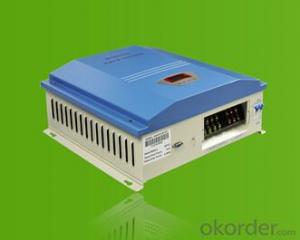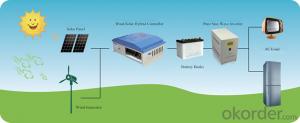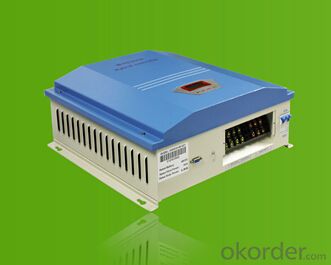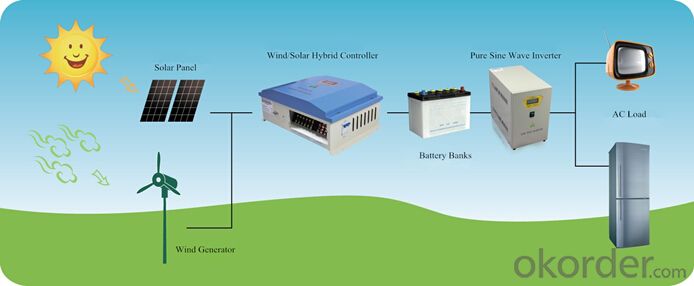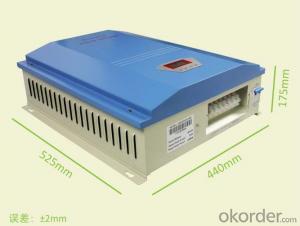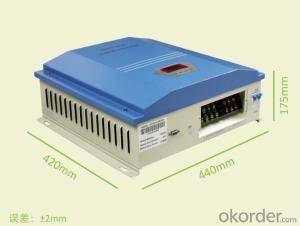Wind Solar Hybrid Controller 1KW-48VPWM Stepless Unload Mode
- Loading Port:
- Shanghai
- Payment Terms:
- TT or LC
- Min Order Qty:
- 1 unit
- Supply Capability:
- 5000 unit/month
OKorder Service Pledge
OKorder Financial Service
You Might Also Like
I. PRODUCT INTRODUCTION
The wind/solar hybrid controller is the control device which can control wind turbine and solar panel at the same time and transform wind and solar energy into electricity then stores to the battery bank.Wind/solar hybrid controller is the most important part in off-grid system, whose performance has much effect on life expectancy and operational stability of the whole system, especially the battery expectancy. Or battery service life will be shortened by over-charge or over-discharge.
II. PERFORMANCE FEATURES
Superior military-grade components to ensure the product stability.
Perfect protection function, thus the system has higher reliability.
Check and set all operation parameters as requirement from LCD display.
Voltage limiting and current-limiting charge mode ensures battery in the best charging status.
PWM stepless unload mode, which burn the excess power into dump load, making the battery charging in best status.
III. APPLICATION AREAS
Stand alone wind/solar hybrid power station; Stand alone domestic household wind/solar hybrid power system.
Mobile communication base stations, expressway and other non-residential regions.
Coastal islands, remote mountainous, border posts for regions shortage of or without electricity.
Government demonstration projects, landscape lighting project.
IV. 1KW TECHNICAL PARAMETERS
Product Model | WWS10-24-N00 | WWS10-48-N00 | WWS10-48-B00 |
Rated Battery Voltage | 24V | 48V | 48V |
Rated Wind Turbine Input Power | 1 kW | 1 kW | 1 kW |
Maximum Wind Turbine Input Power | 1.5 kW | 1.5 kW | 1.5 kW |
Wind Turbine Brake Current | 42 A | 21 A | 21 A |
Rated Solar Input Power | 0.3 kW | 0.3 kW | 0.3 kW |
Floating Charging Voltage | 29V | 58V | 58V |
Dimension (L x W x H) | 442×425×172 mm | Control Box: 205×150×82 mm Dumpload Box: 400×108×50 mm | |
Net Weight | 10 kg | Control Box: 2.2 kg, Dumpload Box: 3.3 kg | |
Display Mode | LCD | ||
Display Mode | Fan | ||
Protection Level | IP20(Indoor) | ||
Quiescent Current | ≤20 mA | ||
Production Functions |
Battery over charge; Battery over discharge; solar reverse charge protection; anti-reverse-connection protection; wind turbine over rotate speed protection; wind turbine over wind speed protection; wind turbine over voltage protection; wind turbine over current protection; manual brake protection; automatically brake protection; lightning protection. | ||
Ambient Temperature | -20~+55℃ | ||
Ambient Humidity | 0~93%,without condensing | ||
Working Altitude | ≤4000m | ||
Data for Micro Current Charge Function | |||
Wind Turbine Start Charge Voltage | 12V | 24V | / |
Dimension(L x W x H) | Control Box: 440×305×170 mm Dumpload Box: 410×270×175 mm | Control Box: 440×305×170 mm Dumpload Box: 300×190×120 mm | / |
Net Weight | Control Box: 7.5 kg, Dumpload Box: 7 kg | Control Box: 7.5 kg, Dumpload Box: 3.5 kg | / |
Data for Low Voltage Charge Function | |||
Wind Turbine Start Charge Voltage | 4V | 8V | / |
Input Admittance Value | 10/15 | 10/60 | / |
Dimension(L x W x H) | Control Box: 440×305×170 mm Dumpload Box: 410×270×175 mm | Control Box: 440×305×170 mm Dumpload Box: 300×190×120 mm | / |
Net Weight | Control Box: 7.5 kg, Dumpload Box: 7 kg | Control Box: 7.5 kg, Dumpload Box: 3.5 kg | / |
In order to serve our customers better. Our company can adjust parameters configuration according to customer’s requirement. | |||

- Q: Can a solar controller be connected to multiple solar panels?
- Yes, a solar controller can be connected to multiple solar panels. The purpose of a solar controller is to regulate and manage the charging process of the solar panels, ensuring optimal performance and preventing overcharging. Connecting multiple solar panels to a solar controller allows for efficient utilization of the solar energy generated by the panels.
- Q: What is the temperature compensation range of a solar controller?
- The temperature compensation range of a solar controller typically varies between -10°C to +40°C.
- Q: How does a solar controller regulate the charging and discharging of batteries?
- A solar controller, also known as a charge controller or solar regulator, is an essential component in a solar power system that regulates the charging and discharging of batteries. Its primary function is to ensure that the batteries receive the optimal amount of charge from the solar panels and prevent overcharging or deep discharging, which can lead to battery damage. The charging process begins when sunlight is captured by the solar panels and converted into electrical energy. The solar controller connects the solar panels to the batteries and acts as an intermediary between them. It monitors the voltage and current output from the solar panels and adjusts the charging process accordingly. During the charging phase, the solar controller controls the flow of electrical energy from the solar panels to the batteries. It employs a technique known as pulse width modulation (PWM) or maximum power point tracking (MPPT) to optimize the charging efficiency. PWM adjusts the voltage and current supplied to the batteries by rapidly switching the charging circuit on and off. MPPT, on the other hand, constantly tracks the maximum power point of the solar panels to extract the maximum available power. The solar controller also incorporates various protection mechanisms to prevent battery damage. It uses voltage sensors to monitor the battery voltage and ensures that it does not exceed the recommended charging voltage. This prevents overcharging, which can lead to battery overheating or even explosion. Additionally, the solar controller monitors the battery’s state of charge and prevents deep discharging, which can reduce battery lifespan. Furthermore, a solar controller often includes additional features such as temperature compensation, load control, and display functions. Temperature compensation adjusts the charging voltage based on the battery temperature to optimize charging efficiency. Load control allows the solar controller to manage the power consumption of connected devices, ensuring that the batteries are not excessively drained. Display functions provide information about the system's performance, including battery voltage, charging current, and system status. In summary, a solar controller plays a crucial role in regulating the charging and discharging of batteries in a solar power system. It ensures that the batteries receive the optimal amount of charge from the solar panels while protecting them from overcharging and deep discharging. With its various control mechanisms and additional features, the solar controller helps maximize the efficiency and lifespan of the batteries in a solar power system.
- Q: What is the maximum solar panel capacity that a solar controller can handle?
- The maximum solar panel capacity that a solar controller can handle depends on the specific model and its specifications. Generally, solar controllers are designed to handle a certain maximum current, typically expressed in amps. So, the maximum solar panel capacity that a solar controller can handle would be determined by the maximum current rating of the controller.
- Q: Can a solar controller be used with a solar-powered greenhouse?
- Yes, a solar controller can be used with a solar-powered greenhouse. A solar controller helps regulate and optimize the charging and discharging of batteries in a solar system. In a solar-powered greenhouse, the controller can manage the flow of energy from the solar panels to the batteries, ensuring optimal power usage and storage. It can also monitor and control various greenhouse functions such as temperature, humidity, and ventilation, contributing to the efficient operation of the greenhouse.
- Q: Can a solar controller be used in a solar-powered gate opener system?
- Yes, a solar controller can be used in a solar-powered gate opener system. A solar controller is responsible for regulating the flow of power from the solar panels to the gate opener, ensuring that the batteries are charged properly and preventing overcharging or damage. By using a solar controller, the gate opener system can efficiently harness and utilize solar energy for powering the gate.
- Q: How do I protect a solar controller from theft or vandalism?
- There are several effective ways to protect a solar controller from theft or vandalism. Firstly, ensure that the controller is installed in a secure and inconspicuous location, such as inside a locked enclosure or a well-protected area. Additionally, use tamper-resistant fasteners or locks to secure the controller in place and deter potential thieves. Consider installing security cameras or motion sensors to monitor the area and discourage vandalism. Lastly, labeling the controller with warning signs or marking it with unique identifiers can help deter theft and aid in recovery if stolen.
- Q: Can a solar controller be used with a solar water pumping system?
- Yes, a solar controller can be used with a solar water pumping system. A solar controller helps regulate and control the power output from the solar panels to the pump, ensuring efficient operation and protection against overcharging or damage to the system. It helps optimize the performance of the solar water pumping system by managing the flow of electricity and protecting the batteries, allowing for reliable and sustainable water pumping.
- Q: How does a solar controller prevent damage from power spikes?
- A solar controller prevents damage from power spikes by regulating and stabilizing the voltage and current output from the solar panels. It acts as a buffer between the panels and the battery or power grid, ensuring that only a safe and consistent amount of energy is transmitted. Additionally, the controller may incorporate surge protection mechanisms to divert or absorb any excessive voltage, safeguarding the system from harmful power spikes.
- Q: Can a solar controller be used with a solar-powered healthcare facility?
- Yes, a solar controller can be used with a solar-powered healthcare facility. A solar controller is an essential component of a solar power system as it regulates the charging and discharging of batteries, ensuring optimal performance and protection. In a solar-powered healthcare facility, the solar controller will effectively manage the energy generated by the solar panels, storing it in batteries for use during periods of low sunlight or increased demand. This ensures a consistent and reliable power supply, supporting the healthcare facility's operations and providing uninterrupted healthcare services.
Send your message to us
Wind Solar Hybrid Controller 1KW-48VPWM Stepless Unload Mode
- Loading Port:
- Shanghai
- Payment Terms:
- TT or LC
- Min Order Qty:
- 1 unit
- Supply Capability:
- 5000 unit/month
OKorder Service Pledge
OKorder Financial Service
Similar products
Hot products
Hot Searches
Related keywords
